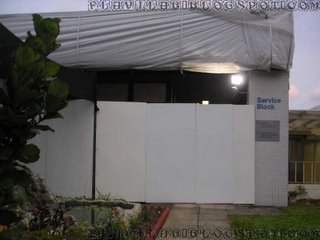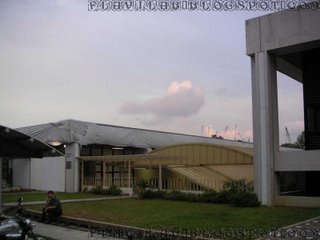Anyway, went to the Rice Table at Suntec. Decent place serving Indonesian food. The whole department went, the attendance sheet officially stating 71 participants. We came, sat down and waited a long time before being served. They had a choice of lime, orange or sour plum juice: all freeflow. Then came the keropok freeflow. What we dicussed and decided was that the people there were knaves who try to make us drink lots of liquids and then give us lots of keropok so that the keropok expands in the stomach with the fruit juice so we can't eat much later on.
The waiters later came with rice, which everybody took very little of, and then the food in nice identical dishes. About 12-13 varieties. Let me try and remember:
Soto ayam (not the best I've tasted)
pickled cucumber (prof likes it)
Rojak buah (prof says its ok)
curry chicken wing (didn't finish the first serving)
sweet black sauce chicken (so-so)
sayur lemak (ordered twice)
tahu telur (TOO OILY!!!)
satay ayam (yum, the thick sweet peanut sauce)
rendang (I personally ate two servings of it)
curry prawn (a favourite)
lady's finger (not bad)
sweet and sour fish (good)
kangkung belacan (good)
otak otak (so-so)
...hmmm....about 14, but have this feeling I missed out one or two.
Anyway, half way through the feast, the HOD gave a speech on how much money in grants the dept has got and how well we are all working and how much harder we must work now, etc. etc.
Then we got back to eating.
But I pitty the people sitting at the HOD's table. Can't enjoy a good lunch. Coz the people there will be too paiseh to eat alot and scared if they order more, the HOD think they glutton or something, and so pretend to be full after the first strand of kangkung.
But my table boh kiek kee. Order the prawns 4 times, satay 3 times, salad, fish, otak...everything take second round, and finish up all. We all is high performance one. Muahahaha....
Ok, ok, pictures:

Nice ambiance:



The ploy:

Why so few choices?

The spread:


Josie's first round:

Soto ayam:

My second round:

Bhu refuses to finish up the curry:

The HOD's table; sorry guys, no second rounds:

Ahhemm....


Escape!:

Trying to fit back a broken branch:



After lunch, we still had an hour to roam around suntec before the bus came to pick us back to campus:

Two of the staffs decided to get a haircut, and the whole department was outside watching... the poor hairdresser, must have been super stressed:

Yup, like I said, the WHOLE department watching one guy get his hair cut:















































